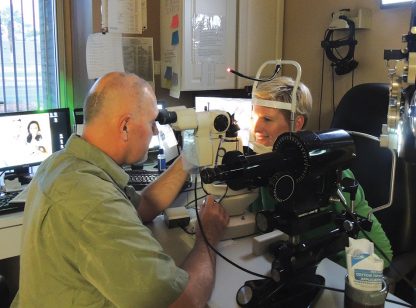A recent article published in the British Journal of Ophthalmology1 helped highlight the difference in eye disease based on whether a diabetic patient is on insulin or not. The study involved over 15,000 patients followed for 9 years. What is interesting is that outcomes were differentiated by any eye disease, sight-threatening eye disease, and something called diabetic macular edema. In diabetic macular edema the central vision (macula) is involved and in most cases vision is affected. I have summarized the results below:
Type 1 Diabetic (insulin-dependent)
- 47% cumulative incidence of any eye disease
- 15% annual incidence of any eye disease
- 18% incidence of sight-threatening eye disease
- 6% annual incidence of sight-threatening eye disease
- 8% cumulative incidence of diabetic macular edema
- 6% annual incidence of diabetic macular edema
Type 2 Diabetic (non insulin-dependent)
- 26% cumulative incidence of eye disease
- 8% annual incidence of any eye disease
- 8% incidence of sight-threatening eye disease
- 3% annual incidence of sight-threatening eye disease
- 6% cumulative incidence of diabetic macular edema
- 2% annual incidence of diabetic macular edema
This data shows us that there are a number of conclusions to make. First, type 1 diabetic patients have a higher incidence of overall disease and sight-threatening disease, as well as macular edema. Second, the incidence risk of going from no diabetic eye disease to the presence of eye disease is relatively high based on yearly evaluations.
Overall, almost 50% of type 1 diabetics and 25% of type 2 diabetics will be identified as having diabetic eye disease.
This study used a screening protocol which did not involve peripheral retinal imaging, and we know from many other studies that more diabetic retinopathy is identified when a dilated retinal exam and examination of the periphery are performed.
When a diabetic patient asks me, “Why do I have to have my eyes dilated every year?” the answer is simple: how diabetes is managed in part is not only due to your blood sugar control but also the level of diabetic complications. That is why not only are eye exams critical to help prevent vision loss; they are also used by the managing physician to help establish the proper level of diabetes control.
Dr. Evans is the founding owner of Evans Eye Care in Palm Desert and can be reached at (760) 674.8806 or online at www.evanseyecare.com.
Reference: 1) Differences in Incidence of Diabetic Retinopathy between Type 1 and 2 Diabetes Mellitus, Pedro Romero-Aroca, et al, Br J Ophthalol. 2017: 101(10): 1346-1351













































Comments (0)